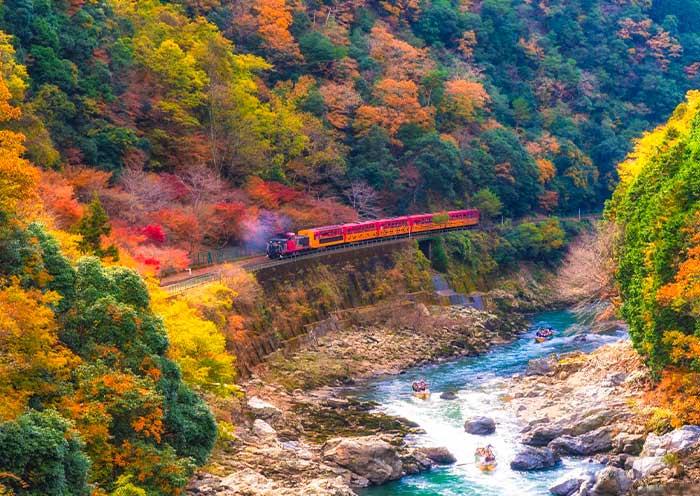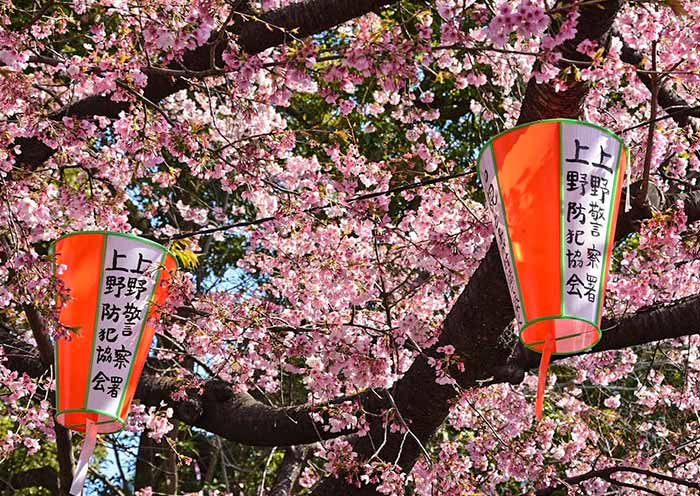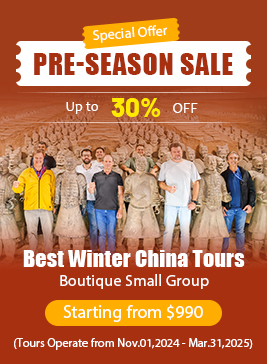Our 8 days group tour in December was amazing! Tokyo’s vibrant streets and Mount Fuji’s snow-capped beauty were breathtaking. Kyoto’s temples and Nara’s deer park offered a serene charm, while Osaka dazzled with its food and nightlife. Hiroshima’s Peace Memorial Park was deeply moving. The crisp winter atmosphere and festive illuminations added a magical touch. Traveling with a small group made the experience fun, seamless, and unforgettable!
8 Days Japan Autumn Leaves Tour: Golden Route from Osaka to Tokyo
From
USD 2700![]()
- This is the price per person, based on a group of 6 people, 4-star hotel accommodation, and travel during the regular season.
- Early-bird rates apply to bookings made at least 6 months prior to the departure date.
- The price is subject to change depending on your travel season, group size, hotel class, and potential fluctuations in currency exchange rates.
- Highlights
- Itinerary
- Price
- Trip Notes
- Accommodation
- Photos
- Reviews
Autumn Splendor: 8 Days of Fall Foliage in Japan
Japan's autumn colors, or koyo, offer a spectacular natural display that often remains overshadowed by the famous cherry blossoms of spring. From late September to early December, landscapes across Japan are transformed into a vibrant tapestry of fiery reds, brilliant scarlets, and regal golds, thanks to the changing hues of Japanese maples and ginkgo trees, along with other species like the Japanese rowan and larch.
Our “ 8 Days Autumn Leaves Tour" traces a path through Japan’s most iconic cities and scenic spots along the Golden Route - Osaka, Nara, Kyoto, Tokyo, Mount Fuji. This meticulously curated itinerary ensures you witness the pinnacle of autumn beauty at must-see sights and premier leaf-viewing locations. Explore the serene beauty of autumn leaves at shrines, temples, and traditional Japanese gardens. Additionally, immerse yourself in nature’s grandeur by taking trains and boat ride and cable car rides to experience stunning views of lakes, snowy mountains, rivers, and valleys framed by autumn colors. This tour offers a perfect blend of cultural heritage and natural beauty, ideal for first-time visitors to see the different facets of Japan in japan autumn season.

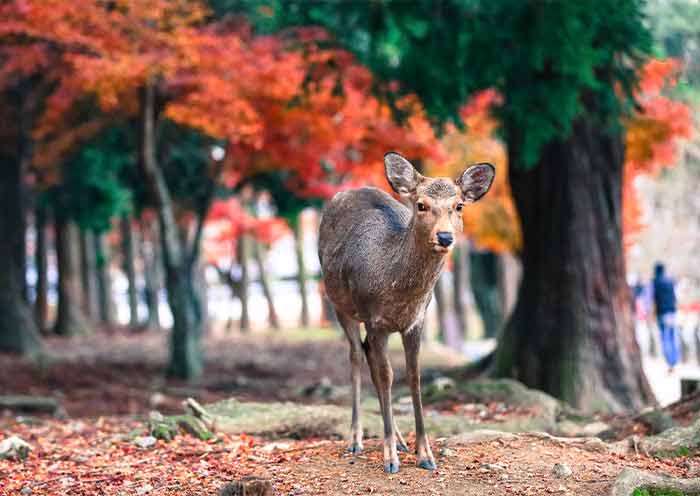


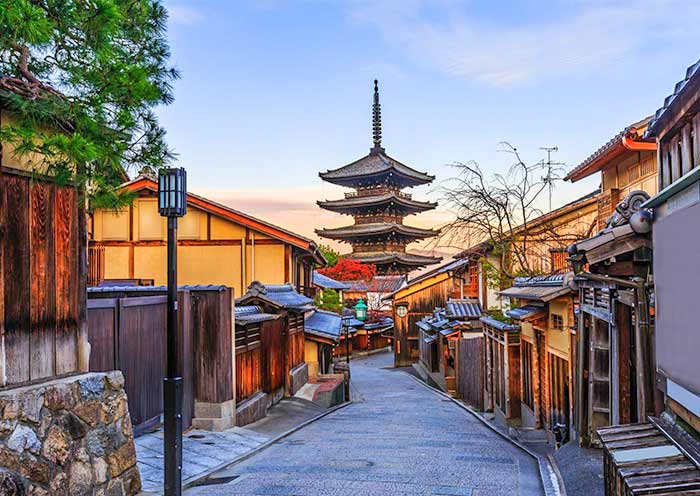

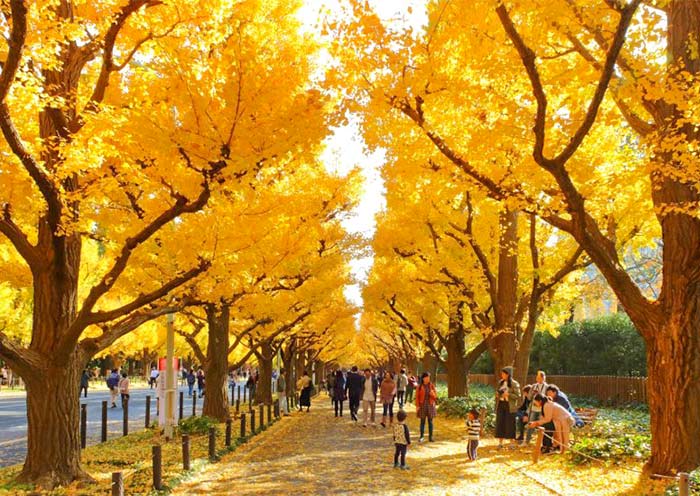
Itinerary at a Glance
Osaka (1.5 Days)
Airport Pick-up, Osaka Castle Park
Japan Nara (0.5 Day)
Todaiji Temple, Nara Park
Kyoto (3 Days)
Fushimi Inari Taisha Shrine, Kiyomizudera Temple, Ninenzaka & Sannenzaka, Gion, Eikando Zenrinji Temple, Sanzenin Temple, Sagano Scenic Railway, Arashiyama Bamboo Grove, Tenryuji Temple, Togetsukyo Bridge, Nishiki Market,
Mt. Fuji & Hakone (1 Day)
Lake Kawaguchi Maple Corridor, Kubota Itchiku Art Museum, Tenjo-san Park Cable Car or Lake Cruise
Tokyo (2 Days)
Meiji Jingu Shrine, Meiji Jingu Gaien Ginkgo Avenue, Shibuya Crossing, Senso-ji Temple, Akihabara
Itinerary Day by Day
Welcome to Japan! Upon your arrival at Osaka's Kansai International Airport, our representative will greet you with a sign bearing your name right at the arrivals gate. Then he will transfer you to your carefully selected hotel in Osaka. Check into your hotel and take some time to settle in and refresh. The rest of today is free for you to explore the local surroundings at your own pace.
Osaka, as Japan's third-largest city and a major economic hub, is renowned for its rich history, diverse cuisine, unique culture, and strong economic power. The city exudes a distinct sense of humor and an open, warm personality, making it exceptionally vibrant and colorful compared to other cities. Across its vast concrete expanse, dazzling neon lights and brightly colored storefronts illuminate the lively nightlife and irresistible culinary scenes. Known as the "nation's kitchen," Osaka is the birthplace of many Japanese culinary delights.
Arrival Ideas:
By Flight: Kansai International Airport (KIX) is the main international gateway to the Kansai region of Japan. It hosts direct flights from major cities across Asia, Europe, North America, and Australia. In addition to international routes, KIX offers a wide range of domestic flights connecting Osaka with major Japanese cities like Tokyo, Sapporo, Okinawa, and Fukuoka. Osaka International Airport, commonly known as Itami Airport (ITM), is located closer to Osaka and primarily handles domestic flights.
By Shinkansen (Bullet Train): Shin-Osaka Station is the city’s shinkansen station. It can be reached via a short train ride from major cities like Tokyo, Nagoya, Hiroshima, and Fukuoka, making it a convenient option if you’re traveling from other parts of Japan.
Free Time Ideas in Osaka:
- Dotonbori: One of Osaka's most iconic areas, Dotonbori is a must-visit for food lovers. This bustling district is famous for its bright neon lights and an array of street food stalls serving Osaka specialties like takoyaki (octopus balls) and okonomiyaki (savory pancakes).
- Shinsaibashi Shopping Arcade: A shopper’s paradise, Shinsaibashi is Osaka’s largest shopping area, stretching over 600 meters and offering everything from high fashion to traditional goods and local snacks.
- Umeda Sky Building: For breathtaking panoramic views of Osaka, head to the Umeda Sky Building. The observatory at the top provides a 360-degree view of the city, and the connecting bridge between the two towers makes for a thrilling experience.
- Shinsekai and Tsutenkaku Tower: Shinsekai, or "New World," is a colorful and nostalgic district of Osaka that reflects the atmosphere of the early 20th century. At the heart of Shinsekai stands Tsutenkaku Tower, an iconic symbol of Osaka which offers panoramic views from its observation deck.
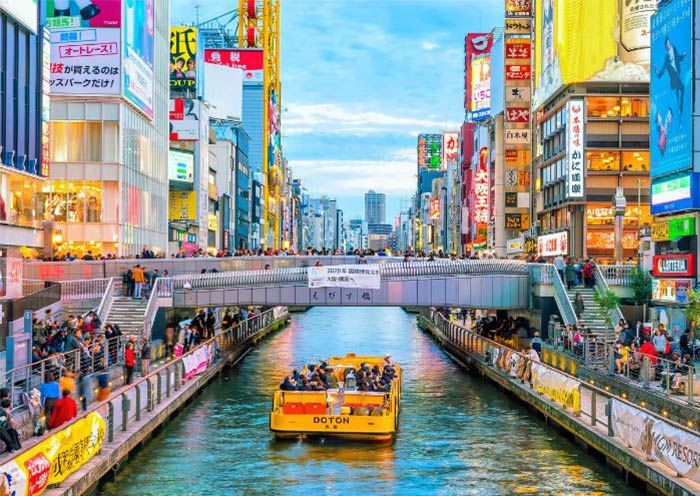
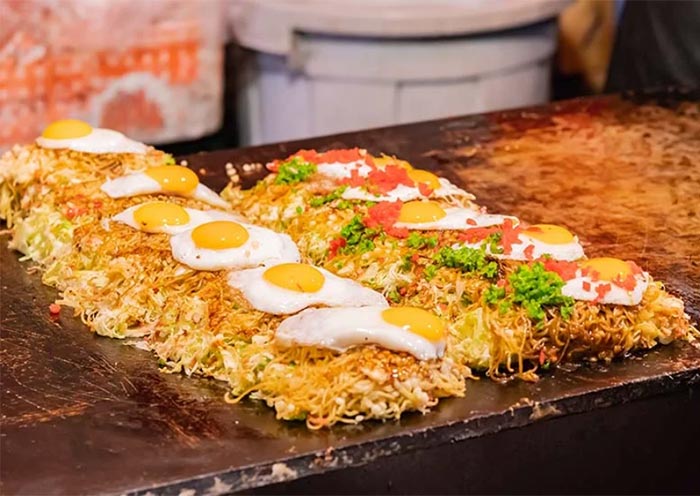
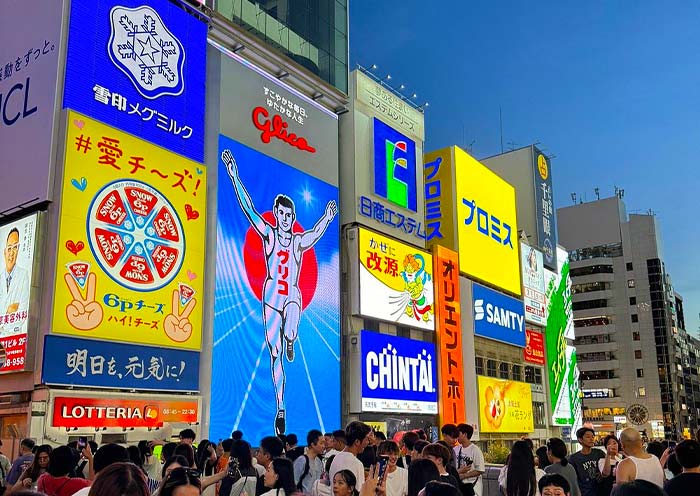
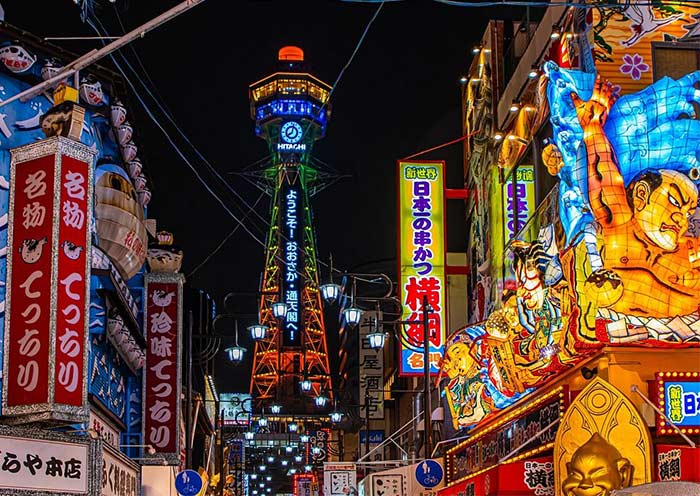
Start your day at Osaka Castle Park, one of Japan’s most famous landmarks and a symbol of Osaka’s historical grandeur. Originally built in 1583 by Toyotomi Hideyoshi, a powerful daimyo who aimed to unify Japan, it was the largest castle of its time. After multiple renovations and reconstructions, today's Osaka Castle has been transformed into an open park, covering a total area of 105.6 hectares, making it a must-visit attraction.The park is home to numerous species of trees, including ginkgo, maple, and zelkova, which all change colors during the autumn. The historic Osaka Castle, with its distinctive green-tiled roof and white walls, provides a stunning contrast against the colorful autumn leaves, offering excellent photo opportunities.
The most breathtaking feature is the Main Tower (Tenshukaku) of Osaka Castle, which stands tall against the sky at the center of the extensive castle grounds. The castle tower's interior is a museum showcasing artifacts related to Toyotomi Hideyoshi and the castle's history. The observation deck on the 8th floor offers a panoramic view of Osaka Castle Park and the Osaka Plain. Optional: Take some time to stroll through the Nishinomaru Garden, this area has a large lawn surrounded by hundreds of cherry and ginkgo trees.
Then, you will depart from Osaka to Nara (takes about 45 minutes). Nara holds a special place in Japanese history as the country's first permanent capital, predating Kyoto. Nara boasts eight World Cultural Heritage sites, making it Japan's second most culturally rich city after Kyoto. In autumn, you'll witness a stunning blend of ancient landmarks, charming deer, and vibrant fall foliage in Nara, making for an exceptionally beautiful experience.
Visit Todaiji Temple, one of Japan's most historically significant temples and a UNESCO World Heritage site. It is known for housing the world’s largest bronze statue of the Buddha Vairocana, which stands just over 16m high and consists of 437 tonnes of bronze and 130kg of gold. It represents Vairocana Buddha and is flanked by two Bodhisattvas. Todaiji's main hall, Daibutsu-den (Big Buddha Hall), is one of the world’s largest all-wood buildings, despite the fact that the present reconstruction of 1692 is only two-thirds of the original temple hall's size.
Walk to Nara Park. This park is famous for its hundreds of freely roaming deer, considered messengers of the gods in Shinto tradition. In autumn, the park transforms into a canvas of red, orange, and yellow hues, with maple and ginkgo trees creating a striking contrast against the ancient temple architectures and the deer that wander amongst the leaves.Purchase some shika senbei (deer crackers) to feed the deer as you stroll through the park.
After the tour, drive to Kyoto to visit Fushimi Inari Taisha Shrine, renowned for its thousands of vermilion torii gates, called Senbon Torii ("thousands of torii gates"). Layers upon layers of vermilion torii gates line the lush, wooded hillside, forming a seemingly endless corridor. The vibrant orange and black gates contrast beautifully with the surrounding greenery, creating a visually stunning and almost otherworldly path that is highly photogenic.
Fushimi Inari Taisha was founded in the early 8th century (711 AD) and is primarily dedicated to Inari, the Shinto god of rice, fertility, sake, agriculture, and industry. As you explore the shrine, you will encounter hundreds of fox statues. Said to be the messengers of the god Inari, who is associated with cereal grains, these fox statues often symbolize the deity. Many of these fox statues are depicted holding a key in their mouths, which is said to open the granary.
Tips: Hiking to the summit of the mountain and back will take two to three hours, but many people go only as far as the Yotsutsuji intersection because there are fewer torii gates beyond this point. It will take 30 to 40 minutes to reach Yotsutsuji.

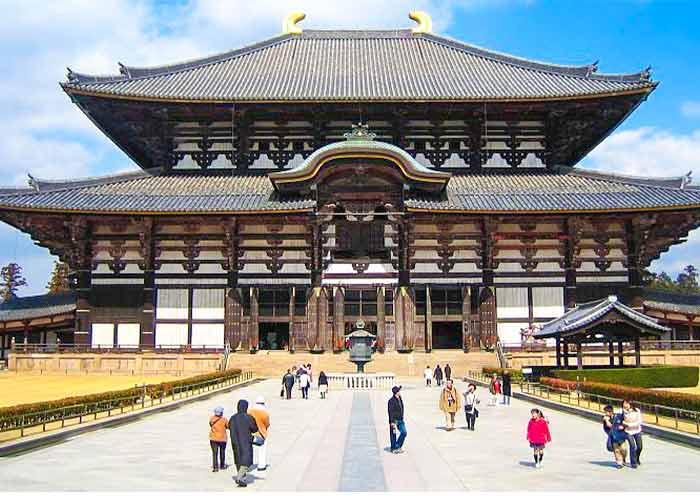


Kyoto, the ancient capital of Japan, boasts a millennium of history and is renowned as a premier destination for viewing autumn leaves. The city has meticulously preserved a vast array of historic architecture, including temples, shrines, and palaces. Many of these sites feature carefully designed gardens that merge seamlessly with the natural landscape. In autumn, these historic sites are enveloped by vibrant maple leaves, enhancing their classical and solemn beauty. Kyoto and its surrounding areas are concentrated with many famous leaf-viewing spots, making it very convenient for tourists to visit multiple scenic locations within a compact area.
First, we will drive north (about one hour) to the Ohara district to visit Sanzenin Temple. More secluded and quiet compared to Kyoto's central attractions, Sanzenin offers numerous opportunities to capture the essence of autumn in Kyoto.
Sanzenin Temple is one of the three temples of the Tiantai Sect. Sanzenin is renowned for its vibrant autumn colors and exquisite garden, surrounded by towering old trees, lush moss, and gurgling streams. The Shuheki-en Garden and Yusei-en Garden are the best places to enjoy the scenery of Sanzenin. These gardens have ponds and are covered in thick moss that looks like green carpets. In autumn, the trees turn red, orange, and yellow, creating a colorful scene against the green moss. This makes for a stunning visual experience. Optional activity: you can sit down for tea here and quietly enjoy the beauty of the garden.
Ojo Gokuraku-in Hall, centrally located in the moss garden, is a designated important cultural property. Inside is enshrined the culturally treasured statue of Amida Sanzon. In the depths of the garden, you will find a number of amusing stone statues that peek out from the moss. These mossy child Jizo statues were hand-carved by sculptor Takashi Sugimura. In Japanese culture, Jizo is considered a guardian of children and travelers. It's great fun to spot these charming little figures in their hiding places.
Next, head downtown to visit Kiyomizudera Temple, a UNESCO World Heritage Site. Perched on the hillside of Eastern Kyoto, this temple is renowned for its wooden stage that juts out over the hill, providing a panoramic view of the city and the surrounding sea of autumn colors. The temple's main hall, constructed entirely without the use of nails, is an architectural marvel. Kiyomizu-dera is also celebrated for its sacred waters, which are believed to have wish-granting powers that draw countless visitors who come to drink from its stream. Don’t miss the Hondo (Main Hall), Jishu Shrine, the Otowa Waterfall, and the spiritual experience of the Tainai-Meguri room.
Then, walk up the well-preserved streets of Ninenzaka and Sannenzaka. These charming, sloping streets are lined with traditional shops and quaint tea houses, offering a nostalgic glimpse into Kyoto's past. As you stroll through these areas, you can shop for unique crafts, sample local snacks, and perhaps stop at a café to relax and soak in the atmosphere of old Kyoto.
Continue to Gion, Kyoto's famous geisha district. Here, you might catch a glimpse of Geisha (Geiko) in their elaborate kimonos and traditional makeup. As you wander through the cobblestone streets of Gion, take a moment to appreciate the beautifully preserved machiya (wooden townhouses), ochaya (teahouses), and exclusive ryotei (traditional Japanese restaurants). Gion is particularly enchanting at dusk when the lanterns are lit and geishas and maiko (apprentice geishas) make their way to evening appointments, making the narrow lanes come alive.
Optional Activities
Evening Stroll Along the Kamo River: This river flows through the city and provides walking paths with beautiful views. Many cafes and restaurants along the river have terraces, perfect for a relaxing end to your day
Stay overnight in Kyoto.
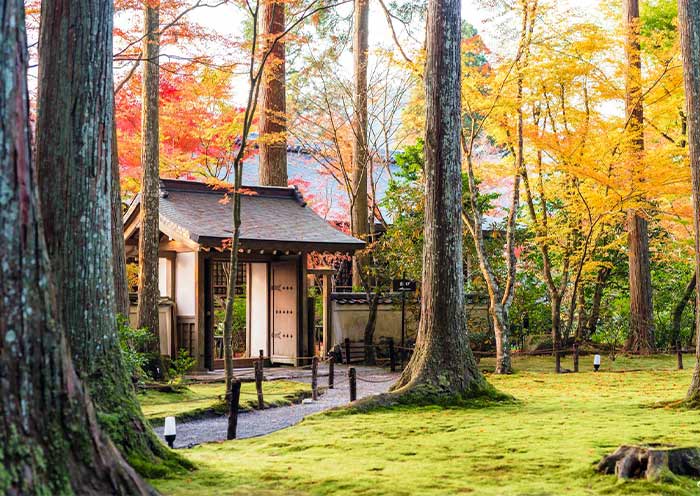



Today, we will explore the western suburbs of Kyoto, immersing ourselves in the stunning vistas of maple leaves amidst the mountains, valleys and forests.
Frist, head to the Arashiyama area in the western part of Kyoto (aboiut 1 hour) and take a ride on the Sagano Scenic Railway, also known as the “Romantic Train”. It is a sightseeing train line that runs between Arashiyama and Kameoka. As the train winds along the Hozugawa River, passengers are treated to spectacular views of the surrounding mountains that are awash in vibrant shades of red, orange, and yellow.
Exit at Arashiyama Station and walk to the nearby Arashiyama Bamboo Grove. The famous pathway is surrounded by towering bamboo, which creates an otherworldly atmosphere. This path leads you through one of Kyoto's most photographed landscapes.
After a short walk, explore Tenryuji Temple which is designated as a UNESCO World Heritage Site and is one of the so-called Kyoto Gozan or "five great Zen temples of Kyoto". Don't miss the garden, designed by the famous Zen master Muso Soseki, which reflects the concept of shakkei ("borrowed landscape"). The temple and its gardens are particularly beautiful during colorful foliage season in autumn.
Next, visit the Togetsukyo Bridge, a historic and iconic bridge that spans the Katsura River, offers one of the best views of the surrounding mountainside draped in autumn colors.
Then, head downtown to visit Nishiki Market, often called "Kyoto’s Kitchen." This vibrant market is the perfect place to sample a variety of local dishes, such as cute Japanese sweets wasabi salt, fresh sashimi skewers to tako tamago (small octopus head stuffed with a quail egg on a stick). Enjoy browsing through the stalls and trying different Kyoto delicacies.
Conclude your visit to Eikando (Zenrinji Temple), one of the famous spots for viewing autumn leaves. Every autumn, the entire temple is surrounded by colorful maple leaves, with the bright red leaves adding a deep autumnal feel to the ancient temple. Along the edges of the temple ponds, the maple leaves reflect on the water, creating a serene and beautiful scene. The temple's Tahoto Pagoda is a two-storied pagoda that offers panoramic views of Kyoto, especially beautiful during the autumn when the surrounding trees are a riot of colors. Additionally, you can view the unique statue of the Amida Buddha, known for its rare pose looking over its shoulder, linked to a legend where the Buddha once called out to the monk Eikan.
Optional Activities
During the autumn season, Eikando hosts an evening illumination event. As night falls, the temple and its gardens are lit up, with the maple trees bathed in lights that create a mystical and dreamlike atmosphere, offering a striking contrast to the daytime scenery and allowing visitors to enjoy the beauty of the leaves under a different light.
Stay overnight in Kyoto.
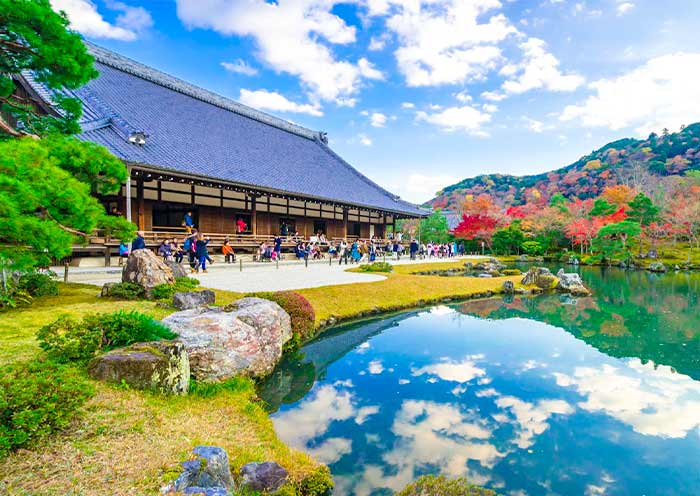
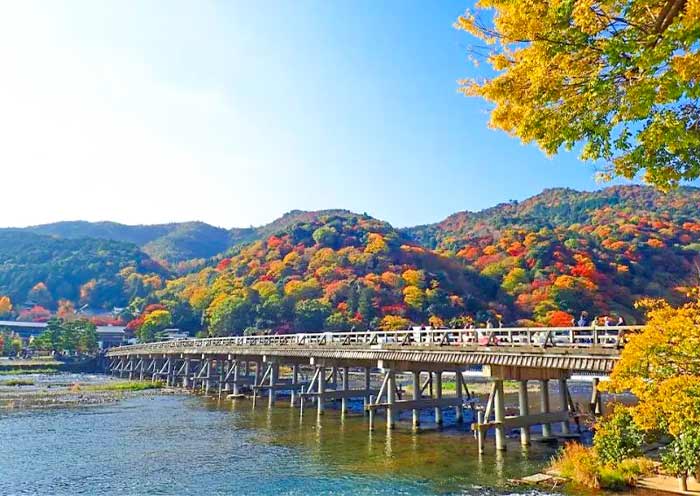

Today, you will take the Shinkansen (bullet train) to Tokyo. A driver will wait for you at the hotel entrance at the scheduled time and transport you to Tokyo Station.
Shinkansen Ride: At Shin-Osaka Station, board the Shinkansen (bullet train) bound for Kyoto Station (about 2.5 hours). This fast and comfortable journey offers a chance to enjoy the changing landscapes of urban and rural Japan.
Upon arrival in Tokyo, a driver holding a sign will wait in the designated area to greet you and provide a private transfer to your hotel. Check into your hotel and take some time to settle in and rest.
Tokyo, the capital of Japan, is one of Japan and Asia's largest economic centers. Tokyo is a hub for Japanese culture and art, with numerous museums, art galleries, theaters, and cultural venues, serving as a vital platform for artistic activities and cultural exchanges. Tokyo stands as a significant base for technological advancement, nurturing numerous high-tech companies and innovative talents, holding leading positions globally in areas like electronics, automotive, and robotics technology.
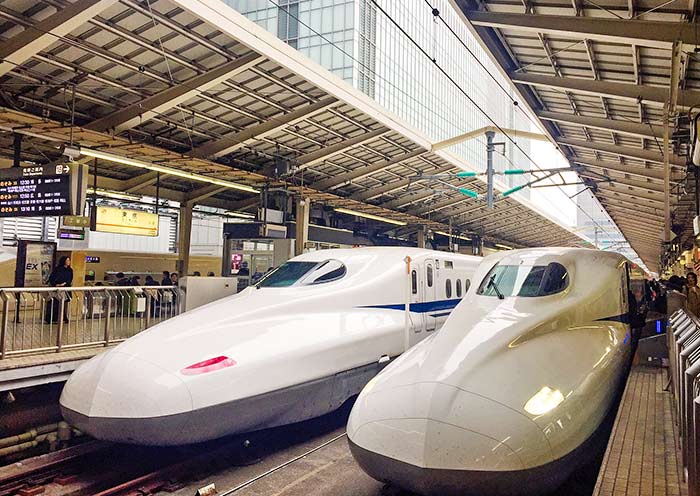

First to visit Meiji Jingu Shrine (Meiji Shrine), a Shinto Shrine dedicated to Emperor Meiji (1852-1912) and Empress Shoken (1849-1914), who played a crucial role in modernizing Japan while excelled in writing Waka (traditional Japanese poems of 31 syllables in the pattern 5-7-5-7-7). Meiji Shrine is also a popular venue for traditional weddings, where you will have the opportunity to witness a Japanese wedding procession and experience the charm of Japanese traditional culture.
The Meiji Shrine is nestled within a tranquil forest that covers an area of 70 hectares, providing a peaceful escape from the bustling city. This forest is home to over 100,000 trees that were donated from regions across Japan during the shrine's construction, in honor of their beloved Emperor Meiji (who established Shinto as the state religion) and Empress Shoken.
Take a stroll along the paths and enjoy the fresh air and natural beauty. You will walk through Japan's largest wooden Torii gate, standing in its natural wooden hue and weighing up to 13 tons. The Torii gate serves as the Symbol of Shinto Shrines, marking the transition from the worldly to the sacred. Then, you will notice the impressive Sake Barrel Wall along the South Approach, which features offerings from sake breweries and believers across Japan, including barrels of sake and Western liquor, reflecting Emperor Meiji's fondness for Western culture.
At the main hall of Meiji Shrine, you can witness locals washing their hands and rinsing their mouths at Purification Font before worship as a sign of respect. You can offer a 5-yen coin (symbolizing a connection) like locals and pray for blessings. In the eyes of the Japanese, Meiji Shrine is considered to have such boundless capabilities, from naming ceremonies for newborns, to coming-of-age ceremonies, graduation ceremonies, seeking marriage partners, praying for world peace, family well-being, safe travels, good health, warding off calamity, etc.
Then, take a walk to Meiji Jingu Gaien, where you'll find the Jingu Gaien Ginkgo Avenue lined with rows of ginkgo trees. Every autumn, as the ginkgo leaves turn yellow, the entire street becomes covered with golden leaves, creating a beautiful scenic view.
Next move to visit Shibuya Crossing, one of the busiest intersections in the world, accommodating approximately 3,000 people per minute. As one of Tokyo's iconic locations, Shibuya attracts tourists and photographers from around the globe who come to observe and capture its essence. Numerous movies, TV shows, commercials, and music videos are filmed at this location, such as "The Fast and the Furious: Tokyo Drift."
Additionally, if you're interested in the story of Hachiko, the loyal dog, you can also visit his bronze statue. This Hachiko statue is located outside Shibuya Station and was erected to commemorate Hachiko's loyalty. Not only is it a popular meeting spot, but it's also a must-visit attraction for tourists. The statue symbolizes the power of loyalty and love, serving as a touching tribute.
In the afternoon, head to Senso-ji Temple (Asakusa Kannon Temple), a must-visit for anyone traveling to Tokyo. While there, be sure to capture a photo of Tokyo Skytree, Japan's tallest tower, visible in the distance.
Senso-ji Temple (Asakusa Kannon Temple), is one of the oldest and most famous Buddhist temples in Tokyo, located in the Asakusa district of Taito, Tokyo. The temple is dedicated to Kannon Bosatsu (Avalokiteshvara), the Bodhisattva of compassion. According to legend, in 628 AD, two fishermen retrieved a statue of Kannon from the Sumida River and decided to construct a temple to enshrine it. Completed in 645 AD, Senso-ji has since become a spiritual symbol of Tokyo.
The temple's entrance is marked by the iconic Kaminarimon (Thunder Gate), featuring a massive red lantern and protective deity statues that symbolize the temple's guardians against evil spirits. This gate is a popular photo spot and marks the beginning of Nakamise Street, a lively shopping street lined with stalls offering traditional Japanese snacks, crafts, and souvenirs, which leads up to the temple's second gate, the Hozomon.
Beyond the Hozomon lies the main hall, dedicated to Kannon and adorned with exquisite decorations, where devotees pray and worship. Adjacent to the main hall is the temple’s five-story pagoda, another striking feature, representing the traditional Japanese architectural style and symbolizing the five elements of Buddhist cosmology - earth, water, fire, wind, and void.
From Senso-ji looking south, you capture a photograph of Skytree Tower (Japan's Tallest Tower; 634 meters). On this street, you can see both old buildings and modern skyscrapers together, providing a visual contrast between traditional and modern.
After that, you can explore Akihabara (The Electric Town).
Akihabara is a district in Tokyo renowned as the center of anime, manga, video games, and electronics. It's a paradise for tech enthusiasts, you'll find countless stores selling anime merchandise, computer parts, and electronics. On the streets of Akihabara, you can see various cosplay enthusiasts showcasing and interacting while dressed in costumes of their favorite anime or game characters.




Today, it will be a full-day round trip (300km) to admire the breathtaking views of Mount Fuji from Lake Kawaguchi, Owakudani, and Lake Ashi.
Mount Fuji is the tallest mountain in Japan. It's a famous volcano with a perfectly symmetrical cone shape. Visiting Mount Fuji is essential for any traveler in Japan. As a UNESCO World Heritage Site, Mount Fuji (3,776m) stands as an iconic symbol of Japan, a cultural and spiritual landmark (recognized as a holy mountain in Shintoism), and a natural marvel. When picturing Mount Fuji, its distinctive perfect cone shape and snow-capped peak likely come to mind. Among the most renowned depictions is Katsushika Hokusai's 'Thirty-Six Views of Mount Fuji'. Hokusai, one of the "Three Greats of Ukiyo-e," is best known for his masterpiece "The Great Wave off Kanagawa" which can be seen on the 1,000 Japanese yen bill.
Start your journey to Lake Kawaguchi for a leisurely walk along the lakeside. Lake Kawaguchi is one of the best places to view Mount Fuji, particularly stunning in the autumn when both the maple leaves and Mount Fuji enhance the landscape. On the north shore of Lake Kawaguchi, the road is draped in a red cloak of leaves, creating a "Maple Corridor (Momiji-kairo) " with about 60 large maple trees standing on either side of the corridor. In November, the annual “Fuji Kawaguchiko Autumn Leaves Festival" is held, drawing visitors from all over to enjoy the breathtaking views and festive atmosphere.
For art lovers, the next stop is the Kubota Itchiku Art Museum, located near Lake Kawaguchi. This unique architectural space houses a collection of beautiful rare kimonos, all designed and created by artist Ichiku Kubota. Ichiku Kubota (1917–2003) was a master textile artist renowned for his exquisitely crafted kimonos. He developed his own complex dyeing techniques, creating intricate patterns and colors inspired by nature, landscapes, and traditional Japanese culture. The tranquil museum setting also offers beautiful views of Mt. Fuji and the lake.
After exploring the museum, choose between two scenic experiences: a cable car ride at Tenjo-san Park or a peaceful cruise on Lake Kawaguchi.
Tenjo-san Park (Cable Car): Take a scenic cable car ride up to the park’s observation area. From the top, you’ll be treated to a stunning 360-degree view of Mt. Fuji, Lake Kawaguchi, and the surrounding countryside.
Alternatively: Lake Kawaguchi Cruise: If you prefer a more tranquil experience, you can opt for a lake cruise on Lake Kawaguchi. This leisurely boat ride offers beautiful views of Mt. Fuji from the water, allowing you to appreciate the landscape from a different perspective.
After that, head back to Tokyo overnight and have a good rest.
Notes:
If the weather is clear, you can enjoy a good view of Mt. Fuji. However, if the weather is not favorable, Mt. Fuji may not be visible.
The best time to view Mount Fuji is generally from Nov. to Feb. when skies are clearer and the peak is snow-capped. Nevertheless, it's important to keep in mind that weather can be unpredictable, and even during these months, there is no guarantee of a clear view.
Early mornings often provide the best visibility before clouds obscure the view. Different locations around Mount Fuji offer varying perspectives, with some spots known for their clear views.



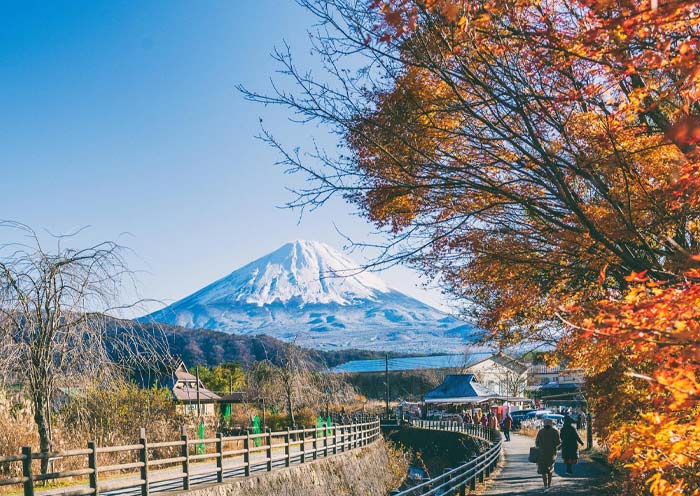
It is time to end your unforgettable 8 Days Japan Autumn Leaves Tour. Your driver will ensure a smooth transfer to Tokyo Narita Airport (NRT) or Tokyo Haneda Airport (HND) for your departure flight.
Trip Extension: If you'd like to extend your adventures in Japan, consider exploring other notable regions like Kobe, Hakone, Hiroshima, Miyajima, etc. Feel free to contact us to customize your extended itinerary.
Thank you for choosing Asia Odyssey Travel for your tour of Asia. We are dedicated to enhancing your travel experiences and look forward to welcoming you on your next adventure in Asia. Have a safe journey home!
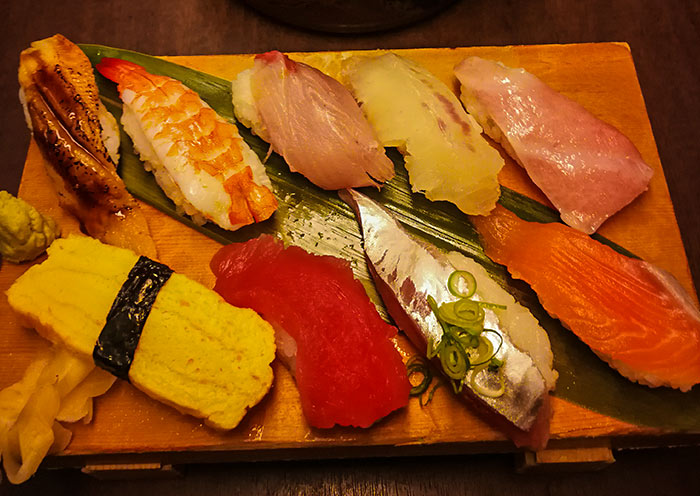
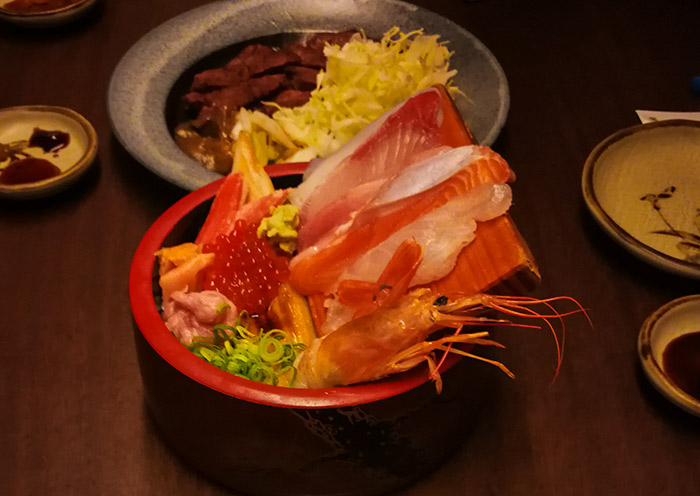
Explore Tour Costs and Request a Free Quote
| Number of People | Autumn Season | Book Tour |
|---|---|---|
| (Oct, Nov, Dec) | ||
| 2 Persons | from $4560 pp | Free Enquiry |
| 4 Persons | from $3110 pp | Free Enquiry |
| 6 Persons | from $2700 pp | Free Enquiry |
What’s Included & What’s Excluded
What's Included:
What's Excluded:
Important Travel Tips for Visiting Japan
Get the right visa. Depending on your nationality and the length of your stay, you may need to apply for a visa in advance. You can do this online or at a Japanese embassy or consulate. Many countries are part of Japan’s visa exemption program, allowing their citizens to enter Japan for short stays without a visa for tourism. Always check if your country is on this list before applying for a visa. If you have any questions, feel free to contact our travel experts for more information.
The best time to visit Japan depends on your interests:
Spring (March to May): Ideal
for witnessing the cherry blossoms and enjoying mild weather. Major cities like Tokyo, Kyoto, and Hiroshima
are particularly beautiful as cherry trees bloom spectacularly.
Summer (June to
August): Perfect for experiencing vibrant festivals such as Gion Matsuri in Kyoto,
Tanabata Matsuri across the country, and enjoying the natural beauty of Hokkaido, which is less humid than
the rest of Japan. Note that early summer (June) is the rainy season.
Autumn (September to
November): Offers stunning fall foliage, making it a great time for hiking and temple
visits. The weather is cool and pleasant, ideal for outdoor activities.
Winter (December to
February): The best time for winter sports, especially in regions like Hokkaido and the
Japanese Alps. Onsens (hot springs) are also a popular attraction during the cold months.
Bring Cash. Despite advances in digital payment, many smaller vendors, temples, and rural
areas operate predominantly with cash. It’s wise to keep some yen on hand at all
times.
Universal Travel Adapter. Japan uses 100V with two straight thin
pins.
Passport: Ensure it’s valid for at least six months beyond your date
of travel.
Visa (if required): Make sure you have the right visa for your
travel.
Travel Insurance Information: Always good to have on hand.
Bow when greeting: A slight bow is a common way to say hello, thank you, or
sorry.
Be mindful of your noise level: Japanese culture values quietness,
especially in public transportation and residential areas.
Follow the rules: Whether
it's waiting in line or adhering to signage, following local rules and etiquette is highly
valued.
Etiquette in temples and shrines: Wear modest clothing and follow specific
customs such as washing hands and mouth before entering a shrine or temple. Photography might be restricted
in sacred areas.
Looking for more travel guides for first-time visitors to Japan? Want to gather additional information to plan your trip? Our team of professional travel experts has written over 40 articles about Vietnam. Please check out ourJapan Travel Guide for inspiration and detailed insights.
Hotel Conditions for Your Japan Tour
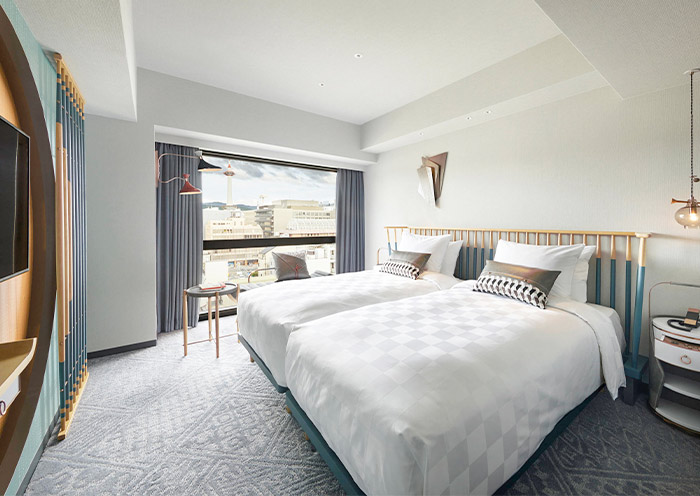

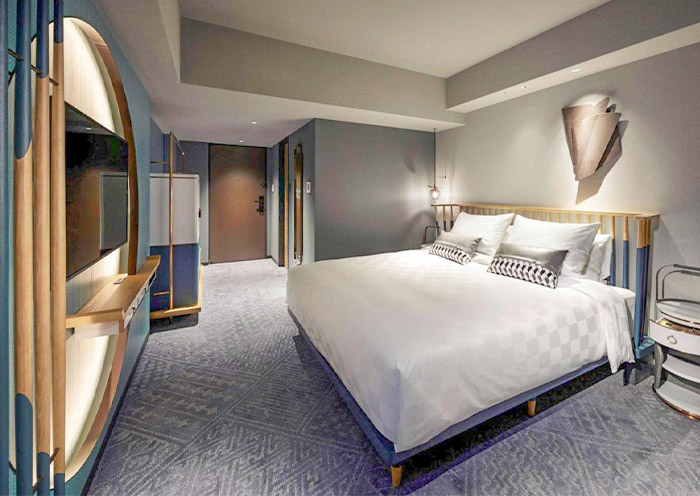

We offer a range of accommodation options to suit various preferences and budgets: luxurious 5-star hotels, comfortable 4-star hotels, and economical 3-star hotels. Our selected hotels are conveniently located close to the city center or popular tourist spots.
For those seeking a more distinctive lodging experience, we also offer Traditional Ryokans, Machiya, Onsen (hot springs) Hotels, etc. If you have specific needs or preferences, please consult with your travel advisor.
Tips: Be aware that hotel room sizes in Japan may be smaller compared to those in other developed countries due to the scarcity of land. If your budget allows, it is recommended to opt for a higher category of hotel, which will generally offer more comfort.
Photo Gallery for This Itinerary
Latest Japan Tours Reviews from Our Customers

Sam Lin
Singapore
Date of Experience: Dec 24, 2024
Tour Customized by: Vincent
You May be Interested in This Tour: 8 Days Best Japan Group Tour: Japan Highlights & Hiroshima

Zhang Xin Hua
Malaysia
Visiting Japan’s Golden Route in October was incredible! From Tokyo's vibrant city life to the serene beauty of Mount Fuji, every stop was unforgettable. Kyoto’s temples and Nara’s friendly deer captured Japan’s charm, while Osaka’s food scene was a delight. The mix of tradition and modernity made it a perfect 7-day journey!
Date of Experience: Oct 26, 2024
Tour Customized by: Allan
You May be Interested in This Tour: 7 Days Japan Golden Route Tour in Small Group

Dan Z
Washington DC
Date of Experience: Aug 24, 2024
Tour Customized by: Rex
You May be Interested in This Tour: 7 Days Japan Kansai Tour with Hiroshima: Osaka, Kyoto, Uji & Nara
Price: From USD 2700 pp
(Based on a private tour for 6 persons staying in 4-star hotels. Prices may vary depending on the itinerary, travel dates, and group size. )
(Book at least 6 months in advance)


